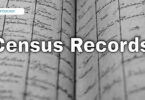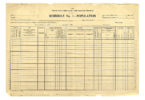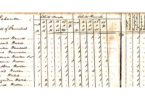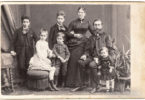The 1810 US federal census was the third national census conducted by the United States government. It began being enumerated on August 6, 1810 and provides an intriguing snapshot of the United States and its people at that exact time in history. It is also a sort of “photograph” in a metaphorical sense for genealogists, as they can use the census to see what their ancestors’ family life looked like at this exact and unique point in time.
The 1810 US federal census showed the United States to have a population of a little over seven million people. Of these, nearly one million two hundred thousand were slaves. One new state was included in this census that was not yet a state in the previous one. That state was Ohio. Like the two censuses previous to it, this particular census has suffered some record losses over the decades, which some genealogists studying and researching American genealogy may find frustrating. The original census returns are missing for Washington, D.C., Georgia, Mississippi, Ohio, and New Jersey. Most of the original returns for Tennessee were also lost, except for Grainger and Rutherford counties.
Copies of some of these returns do exist and can be used by genealogy researchers. However, not all of the returns have copies, or surviving copies, meaning there are significant blanks in this particular census where it concerns genealogy researchers. The missing returns were either destroyed or lost over the decades.
This was the first time that New York appeared as the most populous state in the country on a US census. It held that position until 1970 when California beat it. This was also the last census in which Philadelphia was ranked as the second most populous state, until the 1860 US federal census, when it appeared in that position once more.
The following questions were asked on the 1810 US federal census:
- The name of the city or township being enumerated
- The name of the head of the household
- The number of free white males in a household under the age of ten
- The number of free white males in a household ages ten to fifteen
- The number of free white males in a household ages sixteen to twenty-five
- The number of free white males in a household ages twenty-six to forty-four
- The number of free white males in a household age forty-five and over
- The number of free white females in a household in the same age groups as the free white males
- The number of all free people in a household
- The number of slaves in a household
This census was a pretty basic name and age recording census. It did not ask any of the extra questions that later censuses did, such as occupation, immigration status, military veteran status, disability status, ability to read and write, and other such questions that became staples of later US federal censuses.
Also, this census did not use pre-printed forms, as these did not come into use until the 1830 US federal census. Because there were no pre-printed forms, census enumerators often drew their own columns, and they did so without any uniformity with each other. Some pages, as a result, have no headings for the columns, and results that were not tallied. This makes census results for this and other pre-1830 census a bit idiosyncratic to the individual census enumerators. Interpreting the results may take some time and effort on the part of the genealogy researcher, but this effort is well worth it in terms of the useful and interesting information one can find about one’s ancestors hidden in the handwritten columns and numbers of this US census.
In addition to the new state of Ohio, the following US territories were included in the 1810 US federal census — Orleans Territory (which became the state of Louisiana two years later), Louisiana (which was renamed to Missouri Territory when the state of Louisiana was made out of Orleans Territory), Mississippi, Michigan, Indiana, and Illinois. Illinois is included in the record losses for this census; it only had two counties at the time, St. Clair and Randolph, and the records for St. Clair County were lost. Ohio, as well, suffered significant census record losses, losing everything except the records for Washington County.
The US President during this census was the fourth one, James Madison. Many of the Founding Fathers were still alive at this time, such as Thomas Jefferson and John Adams, which gives you an idea of just how early in American history this census was enumerated. In fact, both of these Founding Fathers, and others can be found in this census. Also, this census was enumerated only seven years after Thomas Jefferson doubled the size of the United States with the Louisiana Purchase. The United States was an up and coming, growing nation at this time, and was just finding its footing and place in the wider world.
In fact, only two years after this census was enumerated, the United States declared war on another nation for the first time since its founding three decades previously. This nation was Great Britain, the nation from which it had so recently won its independence, and the war that was declared became known as the War of 1812. This was a big step for the United States in becoming a universally recognized, accepted, and even respected player in world government and international relations. The fact that the United States won this war is key in its gaining of that respect and recognition. If it had lost, there is every likelihood the United States would have come under British control once more. As it was, its hard-won independence was firmly established by winning this war.
The 1810 US federal census is a valuable genealogical document that should be of use to most people conducting American genealogical research. Just spend some time interpreting it, and you can definitely make amazing discoveries about your family with it.
Download the 1810 Census Blank Form to help you in your research.




